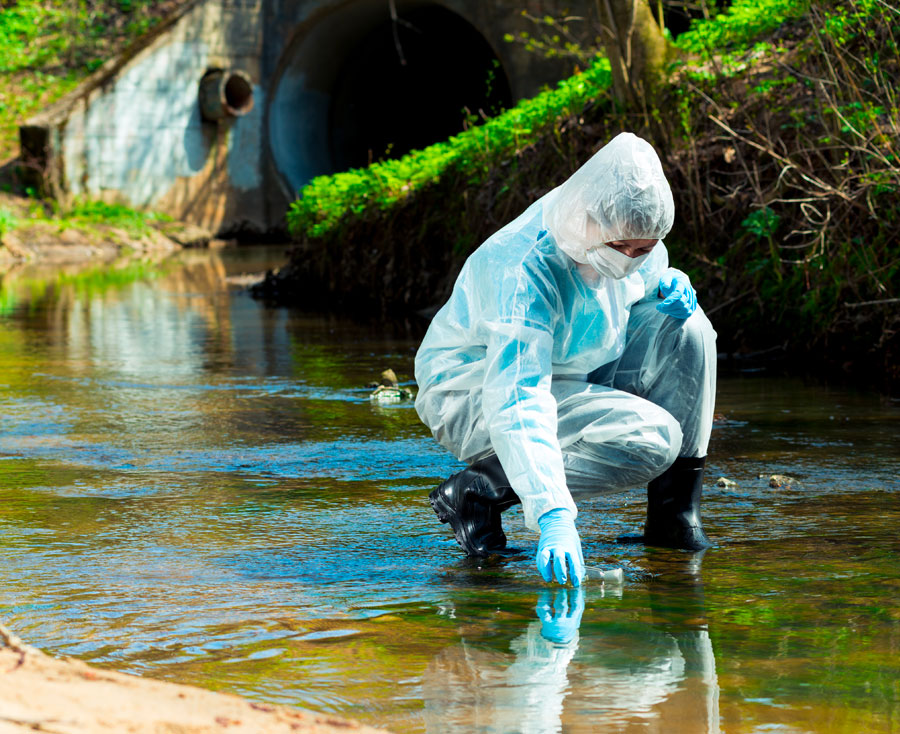Camp Lejeune Water Contamination
Camp Lejeune Water Contamination Lawsuit | Contaminated Water at Camp Lejeune Linked to Cancer and other Health Conditions
For over 30 years, from approximately 1953 to 1987, the water at Marine Corps Base Camp Lejeune was contaminated with dozens of toxic chemicals.
Military service members, their family members, civilian workers, and others who drank and used the contaminated water at Camp Lejeune have experienced a host of tragic health effects, including cancers and other life-altering conditions.
With the August 2022 passage of the PACT Act, which includes the Camp Lejeune Justice Act, water contamination victims are able to file suit and recover damages for their diagnoses and hardships.
If you or a loved one lived or worked at Camp Lejeune for 30 days or more between 1953 and 1987 and subsequently were diagnosed with a related health condition, you may qualify to file a claim.
Contact the experienced attorneys at Burns Law Firm for a free consultation to discuss your legal options, or use the chat feature on this page to see if you qualify instantly.
Frequently Asked Questions
Where is Marine Corps Base Camp Lejeune?
Camp Lejeune is on the Atlantic Coast of North Carolina, nearby Jacksonville, NC. Marine Corps Air Station (MCAS) New River is also situated next to Camp Lejeune.
What was in the water at Camp Lejeune?
Scientific and medical evidence has found that the water at Camp Lejeune was contaminated with over 70 toxic chemicals. The main four chemicals that contaminated water at Camp Lejeune include:
- Trichloroethylene (TCE)
- Tetrachloroethylene (PCE)
- Benzene
- Vinyl Chloride
Who can file a claim for Camp Lejeune water contamination?
Any person who was exposed to contaminated water at Camp Lejeune for at least 30 days between 1953 and 1987, and subsequently was diagnosed with a health condition that may be linked to exposure is encouraged to file a claim.
Those affected have been military service members, veterans, family members of military personnel, civilian workers, contractors, and more. Additionally, family members of deceased former residents of Camp Lejeune can file on their behalf.
What is the average payout for the Camp Lejeune Water Contamination Lawsuit?
The typical settlement amount for Camp Lejeune water contamination lawsuits is not known yet. Settlements for exposure to contaminated water will depend on the health conditions, evidence, amount of time spent at Camp Lejeune and other determining information in each case.
Information on average settlement amounts will be available soon, and our Camp Lejeune attorneys estimate it could be significant for claimants. Camp Lejeune settlement payouts are included for in the Congressional Budget Office (CBO) estimate for the PACT Act, reaching a potential $6.7 billion to be allocated to water contamination victims.
Is the Camp Lejeune lawsuit a Class Action Lawsuit?
No. Camp Lejeune lawsuits are not included in a class action lawsuit. A motion was filed soon after the PACT Act was signed into law to consolidate cases into a class action, but the motion was denied.
The Camp Lejeune Water Contamination Lawsuit: Seeking Justice and Compensation for Victims
For over 30 years, toxic substances contaminated drinking water at Marine Corps Base Camp Lejeune in North Carolina.
Water contamination at the base was rampant, putting upwards of one million people at risk for serious health issues. The Agency for Toxic Substances and Disease Registry (ATSDR) conducted extensive testing of the water at Camp Lejeune, finding the sources of water contamination and identifying what chemicals are most present and dangerous.
Health Effects Suffered by Camp Lejeune Victims
Water contamination at Camp Lejeune has been linked to a variety of tragic health conditions.
The Department of Veterans Affairs (VA) released a list of health conditions that have a “presumptive service connection”, meaning that if a claimant’s health condition appears on the list, they will presume it is linked to water contamination.
The list of VA Presumptive Conditions includes:
- Adult leukemia
- Aplastic anemia and other myelodysplastic syndromes
- Bladder cancer
- Kidney cancer
- Liver cancer
- Multiple myeloma
- Non-Hodgkin’s lymphoma
- Parkinson’s disease
Other health conditions linked to Camp Lejeune water contamination include:
- Breast cancer
- Cervical cancer
- Esophageal cancer
- Lung cancer
- Ovarian cancer
- Stomach cancer
- Renal toxicity
- Scleroderma
- Hepatic Steatosis (Fatty Liver Disease)
- Infertility
- Miscarriage
- Congenital Disabilities (birth defects)
- ALS (Lou Gehrig’s Disease)
The Camp Lejeune Justice Act
The Camp Lejeune Justice Act is a new bill recently signed into law by President Biden as part of the Honoring Our Promise to Address Comprehensive Toxics (PACT) Act. The PACT Act affords new health care benefits, disability benefits, disability compensation, and other benefits to veterans exposed to dangerous chemicals during service.
The Camp Lejeune Justice Act allows Camp Lejeune water contamination victims to file suit and recover damages.
This act is a monumental victory for Marine Corps veterans and their family members. The Camp Lejeune Justice Act overrides a North Carolina law that previously barred lawsuits over water contamination.
The Camp Lejeune Justice Act builds off the legacy of previous attempts to bring justice to victims. President Obama signed the Honoring America’s Veterans and Caring for Camp Lejeune Families Act of 2012, which granted new health care benefits to victims. The Janey Ensminger Act of 2019 sought to improve the Camp Lejeune Families Act.
None of the previous attempts at legislative action have been as comprehensive as this new bill is for former Camp Lejeune residents.
What Chemicals Were in the Camp Lejeune Water Supply?
A shocking amount of toxic substances and volatile organic compounds (VOCs) were found in Camp Lejeune’s water supply.
Upon the 1982 discovery of volatile organic compounds (VOCs) in the water at Camp Lejeune, the Agency for Toxic Substances and Disease Registry (ATSDR) began conducting water modeling tests and health surveys of former Camp Lejeune residents.
The ATSDR’s position on the water contamination situation at Camp Lejeune is as follows:
“past exposures from the 1950s through February 1985 to trichloroethylene (TCE), tetrachloroethylene (PCE), vinyl chloride, and other contaminants in the drinking water at the Camp Lejeune likely increased the risk of cancers (kidney, multiple myeloma, leukemias, and others), adverse birth outcomes, and other adverse health effects of residents (including infants and children), civilian workers, Marines and Naval personnel at Camp Lejeune.”
The four primary chemical contaminants identified in the water at Camp Lejeune were:
- Tetrachloroethylene (PCE or PERC)
Tetrachloroethylene is a non-flammable, colorless liquid chemical used for dry cleaning fabrics and as a metal degreaser. Tetrachloroethylene exposure has been linked to bladder cancer, non-Hodgkin lymphoma, end-stage renal disease, multiple myeloma, liver cancer, kidney cancer, and other health conditions.
- Trichloroethylene (TCE)
Trichloroethylene (TCE) is a man-made organic chemical used in the manufacturing of other chemicals, in refrigerants, in the dry cleaning industry, and as a metal degreaser. TCE exposure has been linked to kidney cancer, non-Hodgkin lymphoma, cardiac defects, leukemia, liver cancer, multiple myeloma, end-stage renal disease, Parkinson’s disease, scleroderma, and other health conditions.
- Benzene
Benzene is a colorless, flammable liquid that is naturally occurring and man-made. Used in the chemical manufacturing of plastics and other everyday items, exposure to Benzene can be deadly. Benzene exposure has been linked to leukemia, non-Hodgkin lymphoma, multiple myeloma, blood disorders, and other health conditions.
- Vinyl Chloride
Vinyl Chloride is a colorless, flammable gas that is used to make polyvinyl chloride (PVC), one of the most common materials for plastic pipes, wires, and packaging materials. Exposure to vinyl chloride has been linked to liver cancer, hepatic steatosis, lung cancer, non-Hodgkin lymphoma, and other health conditions.
Where Did the Water Contamination at Camp Lejeune Originate?
The water contamination at Camp Lejeune originated from multiple places, and some of the contamination is rather undocumented.
Military personnel is said to have dumped industrial wastewater and oil into storm drains. The Environmental Protection Agency (EPA) has also investigated whether radioactive waste was dumped at the base. Contaminants are also said to have leaked from underground storage tanks typically used to store gasoline, oil, jet fuel, and more.
The Agency for Toxic Substances and Disease Registry (ATSDR) identified two water treatment plants that supplied water to the base where contamination levels were significant:
- Tarawa Terrace Treatment Plant
- Hadnot Point Treatment Plant
Nearby Tarawa Terrace Treatment Plant was ABC Cleaners, an off-base dry cleaning facility. This dry cleaner was a significant source of TCE and PCE contamination at Camp Lejeune, which has been linked to a number of cancers and other health effects suffered by victims.
Do I Qualify for the Camp Lejeune Water Contamination Lawsuit?
If you, a loved one, or any family members lived or worked at Camp Lejeune for at least 30 days and subsequently suffered from a health condition that may be linked to exposure to contaminated water, you may be eligible to file a claim.
Family members of deceased victims, as mentioned previously, are eligible to file a Camp Lejeune claim on their behalf.
Evidence for a Camp Lejeune Water Contamination Lawsuit
Those wishing to file Camp Lejeune claims are encouraged to gather as much evidence as possible to raise their chances of having a successful claim.
Camp Lejeune attorneys can help victims find and identify necessary evidence.
Evidence for Camp Lejeune claims may include:
- Medical records and other medical evidence
- Military records
- Employment history as it relates to Camp Lejeune
- Housing information if living on the Marine Corps base
- Records with the Department of Veterans Affairs (VA)
What Can You Seek Compensation For?
Camp Lejeune victims can recover damages similar to how one would against a company in mass tort litigations.
Monetary demands in a Camp Lejeune Water Contamination Lawsuit may include:
- Medical expenses
- Lost wages or lost earning ability
- Disability benefits and other health care benefits
- Future medical expenses
- Loss of consortium
- Other potential damages
What is the Process for Camp Lejeune Claims?
The filing process for Camp Lejeune claims starts with an administrative claims process and a Camp Lejeune Justice Act (CLJA) claim form. The claim form is available on the Navy’s Tort Claims Unit (TCU) website.
The administrative claims form asks claimants for basic information about their time at Camp Lejeune, medical records, and other information. The Navy TCU has six months from the submission of the administrative claims form to respond, either validating or denying the claim.
If an administrative claims form is denied, the claimant will likely file a Camp Lejeune Water Contamination Lawsuit in the US District Court: Eastern District of North Carolina. More information on the legal process for Camp Lejeune lawsuits will be available as the litigation progresses.
If you have any questions or concerns on the claims process or your Camp Lejeune lawsuit, contact Burns Law Firm for a free consultation.
Burns Law Firm: Accepting Clients for the Camp Lejeune Water Contamination Lawsuit
Burns Law Firm is accepting clients from all 50 states for the Camp Lejeune Water Contamination Lawsuit.
Patrick Burns is a decorated attorney and former Judge Advocate General (JAG) for the United States Army, and he’s leading the charge for victims seeking compensation for their diagnoses, injuries, and other damages related to Camp Lejeune water contamination.
Contact the Camp Lejeune Lawyers at Burns Law Firm for a free consultation, or use the chat feature on this page to see if you qualify to file a Camp Lejeune Water Contamination Lawsuit instantly.
Don’t hesitate to reach out today.
_________
“Benzene and Cancer Risk.” American Cancer Society, https://www.cancer.org/healthy/cancer-causes/chemicals/benzene.html.
“Camp Lejeune Claims | Admiralty & Claims Division.” Judge Advocate General (JAG) of the US Navy, https://www.jag.navy.mil/organization/code_15_Camp_Lejeune_Claims.htm.
“Camp Lejeune Justice Act.” H.R.2192 – 117th Congress (2021-2022), https://www.congress.gov/bill/117th-congress/house-bill/2192.
“Camp Lejeune Water Contamination Background.” Centers for Disease Control and Prevention, 16 Jan. 2014, https://www.atsdr.cdc.gov/sites/lejeune/background.html.
“Camp Lejeune Water Contamination History.” Camp Lejeune Water Contamination History | St. Lawrence County, https://stlawco.org/Departments/Veterans/CampLejeuneWaterContaminationHistory.
“Camp Lejeune.” Centers for Disease Control and Prevention, Centers for Disease Control and Prevention, 25 Sept. 2019, https://www.atsdr.cdc.gov/sites/lejeune/index.html.
Congressional Budget Office Cost Estimate. https://www.cbo.gov/system/files/2022-02/HR3967_RCP.pdf.
“Health Effects Linked with TCE, PCE, Benzene, and Vinyl Chloride Exposure.” Centers for Disease Control and Prevention, Agency for Toxic Substances and Disease Registry, 16 Jan. 2014, https://www.atsdr.cdc.gov/sites/lejeune/tce_pce.html.
News, WWAY. “EPA Investigating Whether Radioactive Waste Is Buried at Lejeune.” WWAYTV3, 12 May 2021, https://www.wwaytv3.com/epa_investigating_whether_radioactive_waste_is_buried_at_lejeune-07-2007/.
“President Obama Signs the Honoring America’s Veterans and Caring for Camp Lejeune Families Act of 2012.” National Archives and Records Administration, https://obamawhitehouse.archives.gov/blog/2012/08/06/president-obama-signs-honoring-americas-veterans-and-caring-camp-lejeune-families-ac.
“Tetrachloroethylene (Perc).” Centers for Disease Control and Prevention, 22 June 2020, https://wwwn.cdc.gov/TSP/ToxFAQs/ToxFAQsDetails.aspx?faqid=264&toxid=48.
“Vinyl Chloride – Cancer-Causing Substances.” National Cancer Institute, https://www.cancer.gov/about-cancer/causes-prevention/risk/substances/vinyl-chloride.


